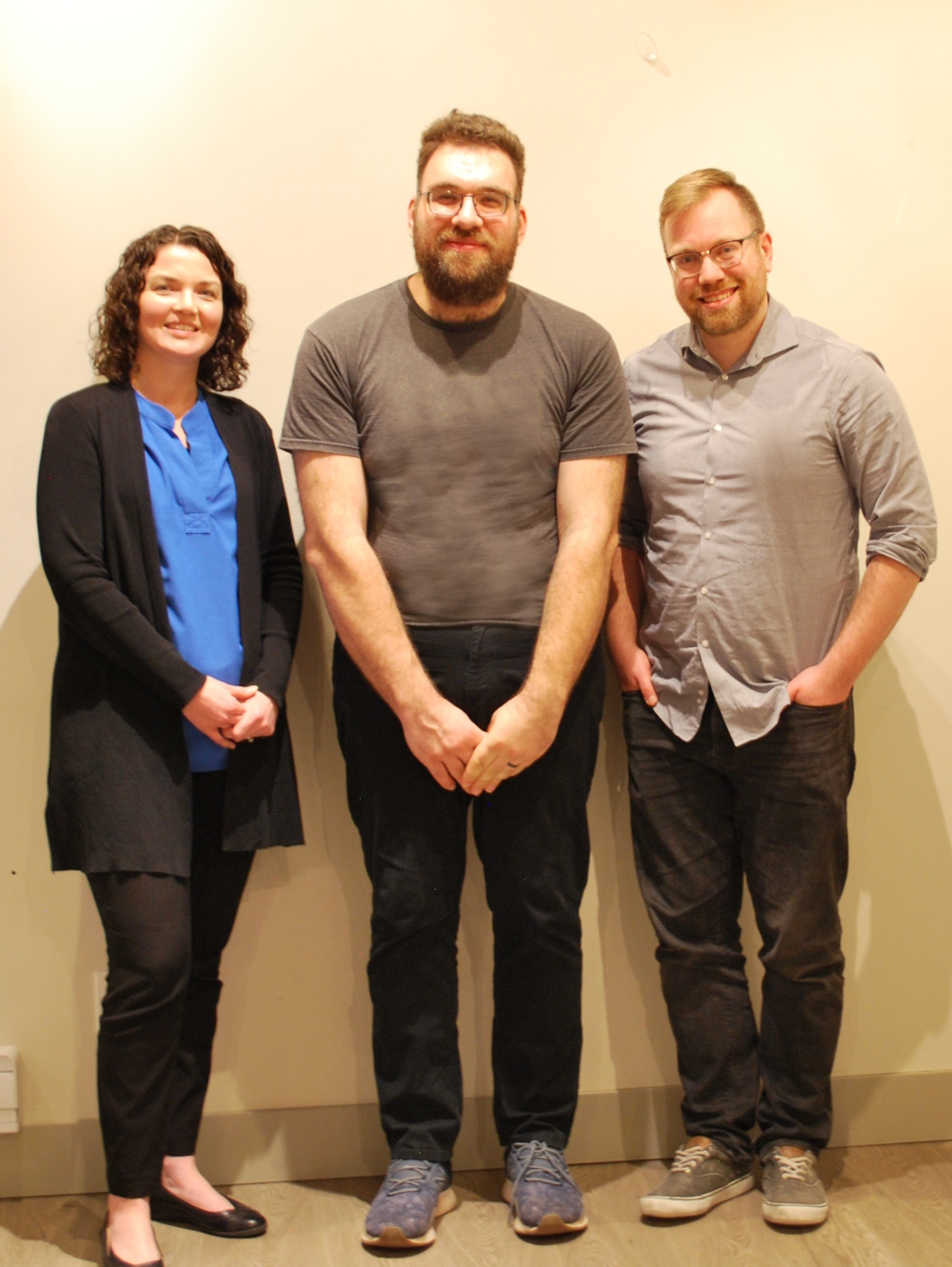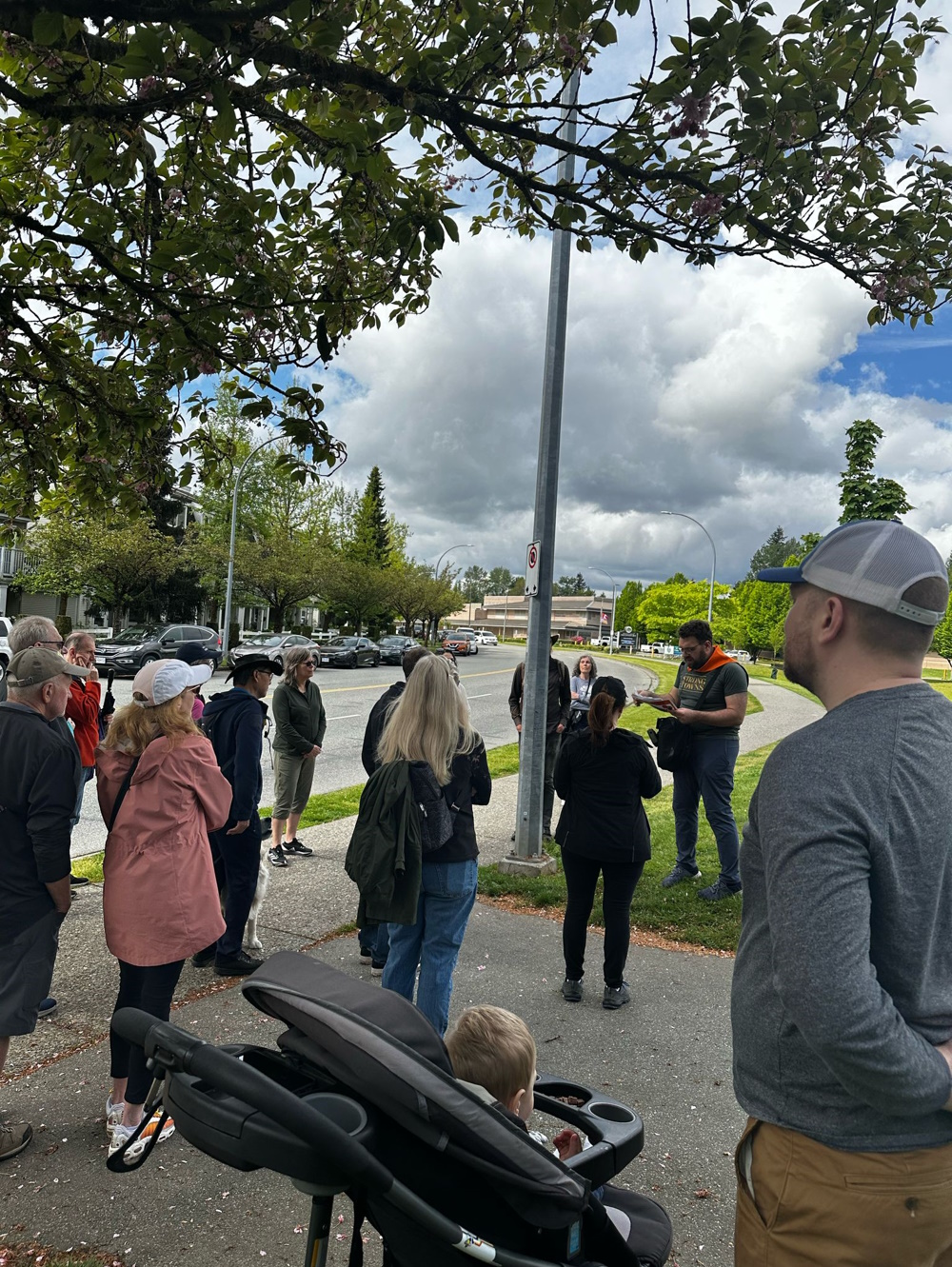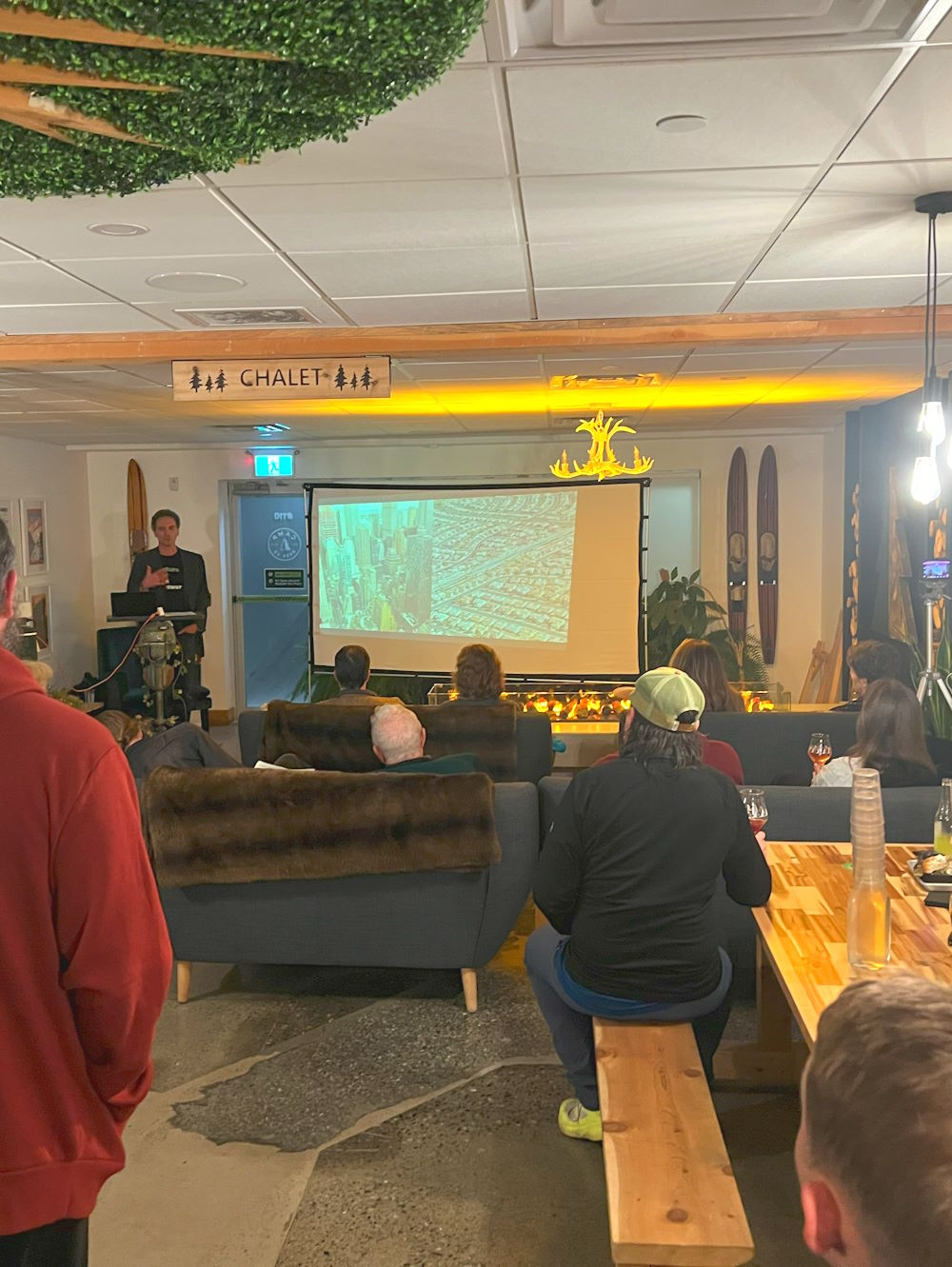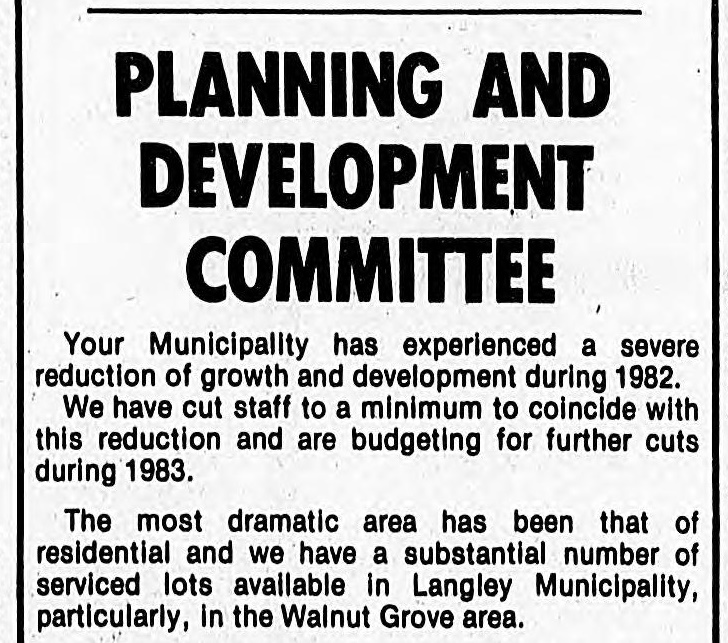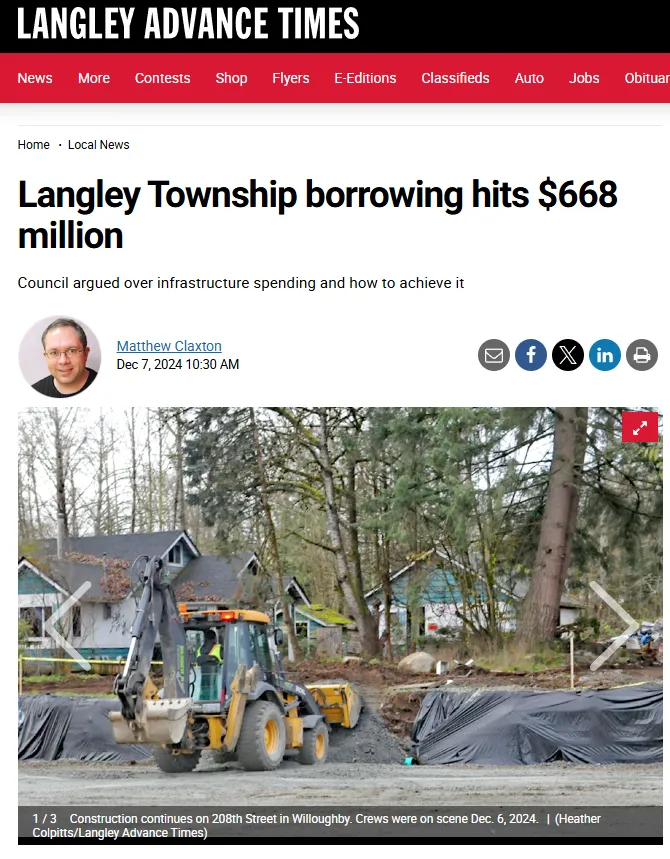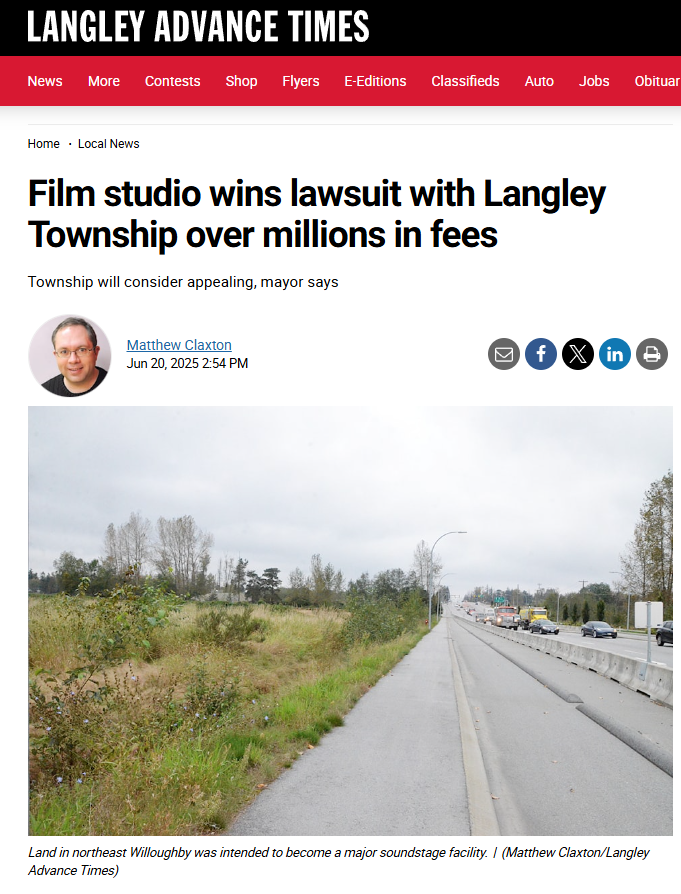Strong Towns Langley has identified significant concerns with the Township of Langley's approach to municipal finance and development strategy. What began as typical suburban sprawl issues—primarily single-family housing developments that generate insufficient tax revenue to cover their long-term infrastructure costs—has evolved into a pattern of increasingly risky financial strategies.
Our analysis reveals how the Township has employed two distinct approaches to address mounting financial and infrastructural deficits, each creating new challenges while attempting to solve previous ones. This cycle of financial dependency on growth raises important questions about long-term sustainability and fiscal responsibility.
This examination covers three distinct periods in our community's development history, showing how each financial strategy has led to the next, ultimately creating our current situation of record debt levels and growth dependency.
Comprehensive Analysis
Is my town trapped in a Growth Ponzi Scheme?
This comprehensive analysis examines how Township of Langley's development patterns have evolved from the 1980s through today's debt-financed infrastructure approach.
Phase 1: The 1980s Walnut Grove Experience
Learning the costs of infrastructure during economic downturns
The Township's transformation into a suburban community accelerated with the development of Walnut Grove and Murrayville in the early 1980s. This period established financial patterns that would influence municipal strategy for decades to come.
The 1982 Recession Impact
Just as Walnut Grove development was underway, the early 1980s recession hit. With interest rates spiking and development slowing, the municipality found itself carrying infrastructure costs for serviced but undeveloped lots.
The 1982 Municipal Stewardship Report documented this challenge:
"We have a substantial number of serviced lots available in Langley Municipality, particularly in the Walnut Grove area."
Long-term Implications
This experience of carrying infrastructure costs during economic downturns would later influence how the Township approached development financing. As Frances Bula documented in her analysis of Fraser Valley growth patterns, the municipality cited this incident as a reason for rejecting front-loading infrastructure investments, as "[financing] those up front [...] would be hard on local taxpayers".
However some argue this incident has been somewhat overblown, as Kurt Alberts, who served in the Township's planning department from the early 1980s to the mid 1990s, explained to Strong Towns Langley via email:
"I don’t believe the story regarding Township bankruptcy [paying for the infrastructure like roads/sidewalks/lights/water/sewer in Walnut Grove] has any credibility [...] For the most part infrastructure was a requirement of the developer(s) of each subsequent Neighbourhood."
But the impact to individual developers was significant:
"The recession that came in 1981 left whole subdivisions within Neighbourhood 2 fully serviced with no purchasers. Prior to the recession new vacant lots were selling for up to $70,000. The bottom literally fell out of the market and I'm sure many developers went bankrupt during that time. When new lots again finally came on the market a few years later, $69,000 got you a lot and a house."
Phase 2: "Grow Faster" - The Willoughby Strategy
2000s-2010s: Subsidizing development to accelerate growth
As infrastructure in older areas like Walnut Grove began reaching end-of-life in the 2000s, the Township adopted what Strong Towns founder Chuck Marohn identifies as a common municipal response to financial pressure.
The Municipal Response to Financial Pressure
Chuck Marohn, from his experience consulting with cities across North America, explains what he observed as the typical first response when municipalities face financial difficulties:
Development Results (2001-2016)
- 800 new single-family homes
- 10,000 ground-oriented units
- 2,000+ new apartments
The Development Fee Freeze Strategy (2007-2019)
To accelerate growth in Willoughby and Yorkson, development fees were frozen for 12 years. This strategy successfully achieved several objectives:
Achieved Goals
- Rapid development in Willoughby/Yorkson
- Increased property tax revenues
- Attracted developers with low fees
- Created denser, more urban communities
Trade-offs
- Infrastructure gaps (incomplete 208 Street)
- Missing sidewalks and arterial connections
- Minimal community facilities
- Deferred infrastructure maintenance
Development Cost Charge History (1991-2024)
How the fee freeze strategy supported rapid Willoughby development
DCC Components
Phase 3: The Debt-Financed Approach
2020s: Addressing infrastructure deficits through borrowing and record-high fees
Following the 2022 municipal election, a new council faced pressure to address infrastructure deficits in Willoughby while pursuing additional community priorities. This led to a strategy combining record-high development fees with significant borrowing.
The New Financial Model
The current approach represents a significant shift from the previous fee-freeze strategy:
Increased Revenue
- Development Fees: ~$42k (2021) → ~$73.5k per unit (2024)
- Community Amenity Contributions: Added in 2018
- Expanded Scope: Beyond basic infrastructure
Debt Financing
- Authorized Debt: $168M → $668M
- Major Projects: Smith Athletic ($154.7M)
- Infrastructure: Road widening, facilities
Legal Challenges and Uncertainties
In June 2025, the BC Supreme Court ruled the Community Amenity Contribution policy "invalid," finding it was "a mandatory amenity payment regime beyond Langley's legal authority." (para.134) Justice Simon Coval's decision affects a significant revenue source, though the Township is in the process of moving to a bylaw using provincial Amenity Cost Charges to eventually replace CACs (para.65). (Lorval Developments Ltd. v. Langley (Township), 2025 BCSC 1148)
Economic Context
The strategy assumes continued growth to service debt obligations. However, broader economic factors may affect this assumption, including significantly reduced Canadian population growth which could lead to reduced housing demand.
Municipal Finance History (2007-2024)
Revenue, debt, and development contributions through all three phases
Financial Indicators
Current Context and Financial Sustainability
Sustainability Considerations
The current debt strategy operates on several key assumptions that face potential challenges:
Continued Growth
Debt servicing depends on ongoing development fee revenue from new projects.
Market Conditions
High development fees may affect project viability during economic downturns.
Legal Framework
Court ruling on CACs creates revenue uncertainty; provincial ACCs pending.
Demographic Trends
National population growth has slowed significantly, potentially affecting housing demand.
Historical Perspective
The 1980s recession experience demonstrates how external economic factors can rapidly change municipal financial conditions:
Lessons from History
- Economic downturns can quickly halt development
- Municipalities may carry infrastructure costs longer than expected
- Revenue assumptions based on continuous growth carry inherent risks
- Financial flexibility becomes crucial during uncertain periods
Key Consideration
While current debt levels may appear manageable, the 1980s experience shows that external factors can quickly alter municipal financial balance. Building resilience into financial planning remains important.
Sustainable Development Alternatives
The Strong Towns methodology emphasizes building community wealth through incremental development that doesn't require municipal subsidies or create long-term financial obligations.
Incremental Development
Infill Development
Encourage density in existing neighborhoods with established infrastructure and proven demand.
Mixed-Use Zoning
Allow neighborhood businesses and diverse housing types to develop organically. Commercial pays higher property tax rates, improving financial performance in residential areas.
Adaptive Reuse
Maximize value from existing built environment and infrastructure investments.
Value-per-Acre Focus
Prioritize areas that generate sufficient tax revenue to sustain their infrastructure.
Financial Resilience
Infrastructure Optimization
Upgrade existing systems rather than building new ones that create additional maintenance obligations.
Lifecycle Cost Analysis
Full accounting for maintenance and replacement costs over infrastructure lifespan.
Diversified Revenue
Reduce dependence on development fees through sustainable tax base growth.
Phased Implementation
Match infrastructure investment timing to demonstrated demand and financial capacity.
Strong Towns Approach
This approach allows communities to grow organically based on market demand while maintaining financial resilience. Rather than requiring subsidies or creating long-term obligations, incremental development builds community wealth gradually and sustainably.
Resources and Further Analysis
Strong Towns Langley Analysis
External Resources
Get Involved in Community Financial Planning
Informed Community Engagement
Understanding municipal finance helps residents make informed decisions about community development priorities and evaluate the long-term sustainability of growth strategies.
Public Participation
- Attend municipal council meetings
- Ask questions about long-term financial sustainability
- Review annual budgets and debt levels
- Examine infrastructure maintenance plans
Development Advocacy
- Consider financial implications of proposed projects
- Support zoning reforms for incremental improvement
- Advocate for value-per-acre analysis
- Promote financially sustainable development patterns
Financial Transparency
Join us in advocating for financially sustainable development that strengthens our community's long-term prosperity.
Stay Informed